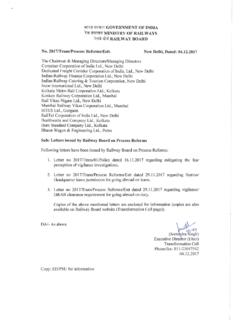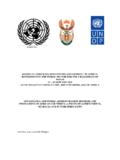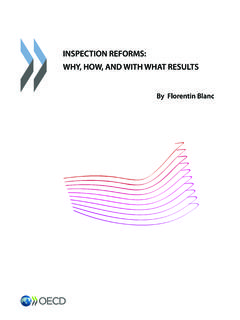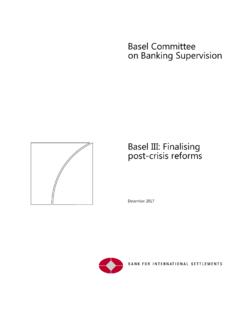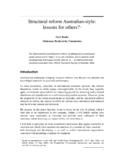Transcription of Education Policy Reforms
1 Education Policy ReformsErwin R. Tiongson2616 Over the last decade, many developing countries have embarked onlarge Education Reforms aimed at rapidly expanding the supply ofeducation, achieving equity in the provision of Education , and signifi-cantly improving the quality of Education . Some of these Reforms havebeen far-reaching, transforming the budget priorities of many countriesand altering in a fundamental way the manner in which governmentshave traditionally made Education services available and how the publicsector has operated in partnership with the private sector. In the process,new relationships of accountability have been number of developments have served as catalysts for in the world economy, the general dissatisfaction with the stateof Education in the 1980s, and findings emerging from academic researchon economic growth, returns to Education , and user fees, among manyother phenomena, have delivered much of the impetus for , a more market-oriented world economy has encour-aged initiatives aimed at creating a more market-oriented environment forthe provision of Education , including measures to foster public-privateapproaches.
2 The new literature on endogenous growth theory, wherein aworker s productivity is seen as a function of both the worker s own humancapital and the average stock of human capital, has offered a fresh perspec-tive on the reasons Education is critical for development. In addition,Erwin R. Tiongson is an economist at the Europe and Central Asia Poverty Reductionand Economic Management Group. He can be reached at and atthe World Bank, 1818 H Street NW, H 4-228, Mail Stop H 4-400, Washington, DC macroeconomic conditions and the leaner public funds follow-ing the debt crisis have encouraged a more efficient use of scarce publicresources. Finally, in recent years, a number of initiatives put forward by theinternational community have made Education a priority on the develop-ment agenda. Through the World Conference on Education for All, held inJomtien, Thailand, at the beginning of the 1990s, and, more recently, theinternationally agreed Millennium Development Goals, the internationalcommunity has reaffirmed its commitment to universal primary chapter provides a brief review of experiences with some ofthese Reforms .
3 In particular, it draws on country case studies and recentfindings from the empirical literature on Education Policy to identifysome of the poverty and social impacts of Education Reforms , the princi-pal transmission channels through which stakeholders are affected by oraffect the Reforms , and the standard tools for poverty and social impactanalysis in Education Policy Reforms have long-term effects on povertyand income distribution, this chapter mainly discusses the distributionalconsequences of Reforms in the short and medium run. Much of the doc-umented impact of Education Reforms concerns the immediate distribu-tional effects of the Reforms rather than the effects of the Reforms on thecurrent poverty status of individuals or households. Whenever appropri-ate, however, we draw out potential immediate effects of Reforms onpoverty. We adopt a broad view of distributional consequences, allowingfor the possibility that Reforms redistribute resources, as well as access,quality, power, and chapter is organized as follows.
4 The first section provides anoverview of Reforms that have been carried out in the Education sector andthe rationale for these Reforms . The effects of Reforms on distribution arethen reviewed, and an analytical scheme for understanding these distrib-utional effects is presented, highlighting how the Reforms vary, mention-ing specific features of each reform , and documenting the transmissionchannels through which stakeholder groups are affected. A survey ofempirical tools for both qualitative and quantitative poverty and socialimpact analyses is provided, and valuable empirical studies on each toolare singled out. Finally, the options for monitoring and evaluation arebriefly OF REFORMT here are several broad changes to Education Policy that are covered in thischapter. In general, these Reforms concern Policy changes to the expendi-Analyzing the Distributional Impact of Reforms262ture structure, the financing scheme, and management, although theremay be significant overlap among these broad categories.
5 We exclude fromthese categories a number of professional and management Reforms (suchas curriculum reform2or teacher training3) that do not have explicit doc-umented impact on distribution. We also exclude financing schemes thatare less common in developing countries, such as student loans. Expenditure government may choose to restructure its expen-ditures to reallocate spending from higher Education to lower levels ofeducation. Reforms aimed at increasing the supply of schooling mayfocus on targeted spending or the expansion of coverage in specificgeographic areas through a mix of public and private sector support,including public support for private Education in low-income areas. Financing government may choose to reform the financing ofeducation by introducing user fees (cost recovery) or, as seen in a num-ber of developing countries in recent years, by eliminating them. Arelated scheme is the introduction of community financing, whereby,for example, communities are entirely responsible for the constructionand maintenance of buildings.
6 Financing schemes may include schemeson the demand side, in which funds are channeled directly towardpeople who demand Education rather than people who supply it tostrengthen the client s power over providers. Demand-side financingschemes may involve transfers to households, vouchers, or paymentsgiven directly to students who may submit them to the schools of theirchoice. Management and institutional country in which there is cen-tralized management over the Education system may choose to imple-ment management Reforms by decentralizing the administration ofeducation. This may involve a shift in responsibility from the central gov-ernment to local governments, communities, or schools. The shift mightinclude a simple delegation of tasks from the central government to localgovernments or a complete transfer of authority and decision-makingpower. The changes may be viewed not simply as administrative adjust-ments, but as Reforms that fundamentally alter relationships of account-ability and the way in which services are provided.
7 The classification ofthese changes as institutional Reforms may then be are, of course, alternative methods for classifying this family ofeducation Policy Reforms . For example, one might contemplate a con-ceptual division between compensatory schemes or targeted policies thataim to increase educational opportunities for the poor and schemes orEducation Policy Reforms263policies that are universal in coverage. The Reforms that have been imple-mented over the last decade may be broadly classified as those that areprimarily aimed at expanding access (expanding supply, restructuringexpenditure, abolishing fees) and those that are primarily aimed atimproving quality, efficiency, and sustainability (decentralization, com-munity management, vouchers).Reimers (2000) suggests that it may be useful to think about educa-tion in terms of levels of educational opportunities, ranging from initialaccess to schooling through progression and completion to assimilationinto local labor markets.
8 Following this typology, one could then under-stand Education Reforms as specific interventions aimed at selected levelsof educational alternative typologies, however, also allow for overlap amongcategories. There are measures, such as the provision of textbooks, thatblur the distinction between access (quantity) and quality. Poor childrenhave been observed to drop out of school with greater frequency, for exam-ple, partly because the quality of schooling is low. Programs exist that arebroad in scope (offering, for example, greater financing for primary edu-cation) but strategically directed at increasing the educational opportuni-ties available to the poor (who may account for a disproportionate shareof enrollment in public primary schools).RATIONALE FOR UNDERTAKING REFORMIn an environment characterized by low Education attainment and in-equitable access to Education , developing countries have typically imple-mented Education Policy reform to improve access to Education , in general,and also to expand coverage among poorer households.
9 Such is the ration-ale for significant additions to budgets for primary Education , constructionprograms, and many compensatory programs targeted at the considerations are also important. A substantial body of lit-erature has emerged over the last three decades on the rate of return to edu-cation. While the methodology has come under scrutiny, there is generalconsensus that the returns to primary schooling are high, thus suggestingthat spending could be switched from higher to lower Education Reforms are designed to improve public finances. Cost recoveryschemes, for example, are designed to supplement government revenueswhen rapid Education expansion has created significant pressure on thebudget. The resources raised may also be used to improve quality and boostdemand for Education . In fact, some advocates of user fees (with waiverschemes built into certain proposals) have supported the institution of costAnalyzing the Distributional Impact of Reforms264recovery on the grounds that such a scheme may improve quality andincrease demand without significantly raising cost barriers.
10 Meanwhile,some Reforms , such as voucher schemes, aim to create a market-orientedenvironment that encourages competition between public and privateschools, enhances school quality, reduces costs, and adds to the choicesavailable to students. Vouchers are also designed to allow students access tohigher quality private and institutional Reforms , such as decentralizationprograms, are designed to improve efficiency, accountability, and respon-siveness in Education service provision. These Reforms follow from theassumption that centralized systems often are not able to respond effi-ciently and adequately to local needs. Decentralization Reforms are meantto encourage local participation and ultimately improve coverage andquality. Sosale (2000) has suggested that the strengthening of the privatesector role in noncompulsory Education is also aimed at releasing publicresources for allocation to the compulsory basic Education , political pressures from within and outside a country haveprofound effects on educational policies, such as Free Primary Educationor Education for All.













